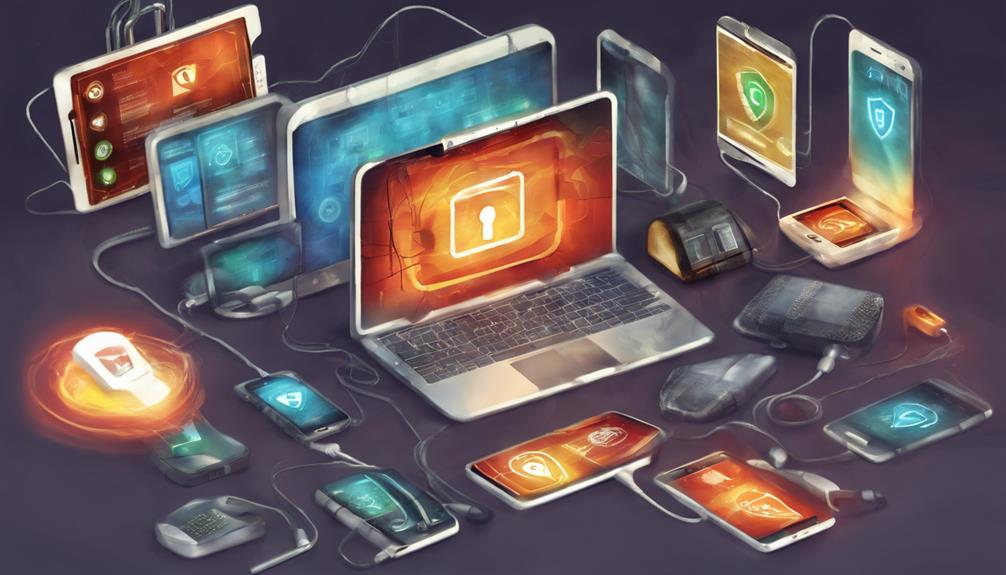To safeguard against hackers, prioritize strong password creation using a mix of characters. Implement Two-Factor Authentication (2FA) for extra security layers and update anti-virus software regularly. Exercise caution on public Wi-Fi, use VPNs, and be selective with app downloads. Stay vigilant against phishing attempts, avoid clicking on suspicious links, and backup data securely. Remember, 'over 90% of successful cyber attacks originate from phishing emails,' so verification is key. Remaining proactive with app permissions, erasure practices, and link handling is vital. These practices form a robust defense against cyber threats, focusing on prevention and security at every digital interaction.
Key Takeaways
- Utilize strong, unique passwords with a mix of characters.
- Enable Two-Factor Authentication (2FA) for added security.
- Keep anti-virus software updated and schedule routine scans.
- Avoid clicking on suspicious links and attachments.
- Use VPNs on public Wi-Fi and stay vigilant against phishing attempts.
Strong Password Creation
Utilizing complex and unique passwords is essential in safeguarding personal information from potential hacking threats. When creating passwords, it is important to incorporate a mix of characters such as uppercase letters, lowercase letters, numbers, and special symbols to enhance security.
Avoiding the reuse of passwords across different accounts is equally vital as it reduces the risk of a single password compromise leading to multiple breaches.
To effectively manage a multitude of passwords, utilizing password managers is highly recommended. These tools securely store and organize passwords, ensuring that each account has a unique and strong password.
Additionally, implementing Two-Factor Authentication (2FA) provides an extra layer of protection against hacking attempts, requiring not only a password but also a secondary verification method.
Furthermore, turning off auto-complete features on browsers and devices can prevent password leaks and further enhance security. By following these best practices, individuals can significantly reduce the risk of falling victim to cyber threats.
Email Security Best Practices

When it comes to safeguarding your email accounts, it is essential to implement strong password practices and maintain awareness of phishing attempts.
By using complex passwords that incorporate a combination of letters, numbers, and special characters, you can enhance the security of your email communications.
Additionally, staying vigilant against phishing emails that aim to deceive you into disclosing sensitive information is paramount to mitigating cyber threats.
Strong Passwords
Enhancing email security begins with the creation of long, unique passwords containing a diverse mix of characters. Using strong passwords is vital in safeguarding your email account security against hacking incidents and cyber threats.
It is essential to avoid reusing passwords across different accounts to maintain the integrity of your email security. Additionally, implementing Two-Factor Authentication (2FA) adds an extra layer of protection to your email account.
Utilizing password managers can assist in securely storing and managing your passwords, ensuring they remain complex and unique.
When dealing with email security, being cautious of phishing emails is paramount. Always verify the authenticity of email attachments and links to mitigate potential cyber threats.
Phishing Awareness
A critical aspect of maintaining robust email security involves developing a keen awareness of phishing tactics and implementing best practices to safeguard against malicious cyber threats. Phishing emails are a common cybercriminal tactic used to deceive individuals into divulging sensitive information. It is crucial to recognize phishing attempts by verifying the sender's email address and refraining from clicking on links or downloading attachments from suspicious emails. In 2020, 76% of organizations fell victim to phishing attacks, highlighting the prevalence and effectiveness of these scams. To protect against phishing, individuals should undergo phishing awareness training to learn how to identify and avoid falling for phishing schemes. Cybercriminals often employ urgency or fear tactics in phishing emails to prompt immediate action, emphasizing the importance of taking a moment to verify the legitimacy of any email before responding.
| Phishing Awareness Tips | Description |
|---|---|
| Recognize Phishing Attempts | Learn to identify common signs of phishing emails |
| Avoid Clicking on Links | Refrain from clicking on links in suspicious emails |
| Verify Sender's Email Address | Always verify the authenticity of the sender's address |
| Phishing Awareness Training | Educate yourself on how to protect against phishing scams |
Two-Factor Authentication Importance

The importance of two-factor authentication in safeguarding online accounts against unauthorized access cannot be overstated. By requiring two forms of verification, such as a password and a unique code sent to a user's phone, two-factor authentication adds an extra layer of security that greatly reduces the risk of hacking attempts.
Common methods of two-factor authentication include SMS codes, authenticator apps like Google Authenticator, and biometric verification such as fingerprint or facial recognition. In fact, studies show that 90% of Google account hacks could have been prevented if two-factor authentication was in place.
Implementing 2FA provides an added level of protection for online accounts, making it harder for cybercriminals to gain unauthorized access. By utilizing this security measure, individuals can effectively prevent unauthorized access and enhance the overall security of their online accounts.
Regular Anti-Virus Updates

Regularly updating your anti-virus software is crucial in safeguarding your device against the ever-evolving landscape of cyber threats. By scheduling routine scans and enabling auto-updates, you guarantee that your system is fortified with the latest security patches and threat definitions.
Neglecting these updates can expose your device to potential hacking attempts, underscoring the critical importance of maintaining the integrity of your anti-virus protection.
Update Anti-Virus Software
To safeguard your digital devices against cyber threats, guaranteeing timely updates for your anti-virus software is imperative. Updating your anti-virus software is essential to stay protected against a myriad of cyber threats.
These updates not only include critical security patches that fix vulnerabilities but also enhance your device's defense mechanisms against malware, ransomware, and other malicious attacks. Outdated anti-virus software can leave your system exposed to various risks, making it easier for cybercriminals to exploit weaknesses in your system.
By regularly updating your anti-virus software, you enable it to detect and remove known viruses, Trojans, worms, and spyware effectively. Setting up automatic updates for your anti-virus software is a convenient way to ensure continuous protection against the latest cyber threats, as it automatically installs the necessary updates without requiring manual intervention.
Stay proactive in updating your anti-virus software to fortify your digital defenses against the ever-evolving landscape of cyber threats.
Schedule Regular Scans
Implementing scheduled scans for your anti-virus software is essential in maintaining a secure digital environment. Regular scans serve as a pivotal measure to protect your information from the latest hacking threats and malicious software. By scheduling these scans, you can reduce the risk of unauthorized access to your device and data, ultimately avoiding falling victim to cyber attacks.
Updating your anti-virus software is vital, but without regular scans, your system may still be vulnerable to evolving threats. These scans help in detecting and eliminating any potential security breaches or vulnerabilities that could be exploited by hackers. By staying vigilant with scheduled scans, you guarantee that your device remains secure and your sensitive data is safeguarded.
In today's digital landscape where cyber threats are constantly evolving, regular scans are a fundamental aspect of maintaining a robust defense against unauthorized access and potential breaches. Make it a habit to schedule these scans to fortify your digital defenses and keep your information safe from harm.
Enable Auto-Updates
Consistently enabling auto-updates for your anti-virus software is essential in ensuring your digital defenses are up-to-date against emerging cyber threats. By allowing your anti-virus software to automatically update, you are safeguarding your system against security vulnerabilities that hackers often exploit during cyber attacks.
Outdated anti-virus software is a prime target for malicious activities, making auto-updates critical for maintaining a robust shield against evolving hacking techniques.
Automatic updates not only bolster your protection but also save you time and effort by eliminating the need for manual software checks and installations. It is imperative to stay proactive in fortifying your devices with the latest security patches through auto-updates, as hackers are constantly devising new methods to breach systems.
Secure Public Wi-Fi Usage

Ensuring the security of your online activities while using public Wi-Fi networks is essential in safeguarding your personal data from cyber threats. Public Wi-Fi networks are prime targets for hackers, with a significant number of individuals expressing worries about potential data breaches.
To protect yourself, consider using Virtual Private Networks (VPNs) when connecting to public Wi-Fi. VPNs create encrypted tunnels that prevent cybercriminals from intercepting your data.
It's important to avoid accessing sensitive information such as bank accounts or passwords while on public Wi-Fi to minimize the risk of falling victim to malicious attacks. Be cautious when connecting to public Wi-Fi, as hackers can easily create fake hotspots to lure unsuspecting users.
Strengthen your defenses by disabling file sharing and activating firewall protection on your devices when using public Wi-Fi. These measures enhance security and reduce the chances of your personal data being compromised.
App Selection Guidelines

When selecting apps for your devices, prioritize downloading from reputable sources with positive reviews and high ratings to minimize the risk of malware or viruses. Ensuring that the apps you download are from trustworthy sources is essential in protecting your data and maintaining the security of your device. Here are some guidelines to help you make informed decisions:
- Regularly Update Apps:
Keeping your apps updated is vital to protect against security vulnerabilities. Developers frequently release updates that include security patches to address potential threats.
- Mind App Permissions:
Be cautious when granting permissions to apps, as some may request access to unnecessary personal data or sensitive information. Review and consider the permissions an app requests before granting access.
- Avoid Auto-Complete:
Refrain from using auto-complete features for passwords within apps. Disabling this feature can prevent unauthorized access in case of a security breach.
Caution With Links & Attachments

Exercise vigilance when interacting with links and attachments to safeguard against potential cyber threats. Phishing emails, texts, and fake websites are commonly employed by hackers to deceive users, with over 90% of successful cyber attacks originating from a phishing email.
To avoid falling victim to such tactics, it is important to refrain from clicking on suspicious links or opening unknown attachments, as these actions can lead to malware installation on your device. Verifying the authenticity of emails and attachments before taking any action is essential to protect against hacking attempts.
Cybercriminals often resort to social engineering techniques to manipulate users into clicking on malicious links or downloading harmful attachments. By remaining cautious and discerning in your online interactions, you can greatly reduce the risk of falling prey to cyber threats orchestrated through phishing emails, suspicious links, and unknown attachments.
Data Backup & Erasure Practices

Implementing robust data backup and erasure practices is essential for safeguarding sensitive information from potential security breaches and cyber attacks.
To enhance data protection, consider the following:
- Regularly back up your data using encryption tools to mitigate the risk of unauthorized access by hackers. Secure data backup guarantees that even if one system is compromised, the information remains safe and accessible.
- Utilize secure data erasure methods, such as data wiping software, to completely remove sensitive data from devices. This prevents hackers from retrieving deleted information and reduces the likelihood of a data breach.
- Explore cloud storage options for automated and secure data backups. Cloud storage offers additional layers of security and redundancy, making it a reliable solution for protecting critical information from cyber threats.
Frequently Asked Questions
What Are 5 Ways You Can Avoid Being Hacked?
To avoid being hacked, it is essential to implement robust cybersecurity measures. Utilize strong, unique passwords, enable two-factor authentication, exercise caution with emails and links, update software regularly, and be mindful of public Wi-Fi security risks.
What Can Protect You From Hackers?
Cybersecurity breaches cost businesses an average of $3.86 million per incident. Protecting yourself from hackers involves using strong passwords, enabling Two-Factor Authentication, updating software, being cautious of phishing emails, and monitoring account activity.
Which Is Safest Against Hackers?
The safest measure against hackers is implementing Two-Factor Authentication (2FA) due to the markedly enhanced layer of security it provides. This method greatly reduces the risk of unauthorized access to accounts by requiring a second form of verification.
How Do Hackers Avoid Being Tracked?
Hackers employ an intricate web of tactics to avoid being tracked, including utilizing VPNs, proxy servers, encryption tools like Tor, spoofing techniques, and constantly changing online identities. Their elusive maneuvers create a digital cloak of anonymity.
Conclusion
In conclusion, staying safe from hackers requires a combination of strong password creation, email security best practices, two-factor authentication, regular anti-virus updates, secure public Wi-Fi usage, cautious app selection, and data backup practices. By following these guidelines, individuals can significantly reduce their risk of falling victim to cyber attacks. It is important to stay vigilant and proactive in protecting personal information online to avoid potential security breaches.
According to a report by Cybersecurity Ventures, it is estimated that cybercrime will cost the world $6 trillion annually by 2021. This staggering figure highlights the growing threat of hackers and the importance of taking proactive measures to protect oneself online.









